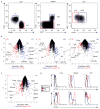Transcriptional programs define molecular characteristics of innate lymphoid cell classes and subsets
- PMID: 25621825
- PMCID: PMC4372143
- DOI: 10.1038/ni.3094
Transcriptional programs define molecular characteristics of innate lymphoid cell classes and subsets
Abstract
The recognized diversity of innate lymphoid cells (ILCs) is rapidly expanding. Three ILC classes have emerged, ILC1, ILC2 and ILC3, with ILC1 and ILC3 including several subsets. The classification of some subsets is unclear, and it remains controversial whether natural killer (NK) cells and ILC1 cells are distinct cell types. To address these issues, we analyzed gene expression in ILCs and NK cells from mouse small intestine, spleen and liver, as part of the Immunological Genome Project. The results showed unique gene-expression patterns for some ILCs and overlapping patterns for ILC1 cells and NK cells, whereas other ILC subsets remained indistinguishable. We identified a transcriptional program shared by small intestine ILCs and a core ILC signature. We revealed and discuss transcripts that suggest previously unknown functions and developmental paths for ILCs.
Figures






Comment in
-
Profiling the diversity of innate lymphoid cells.Nat Immunol. 2015 Mar;16(3):222-4. doi: 10.1038/ni.3107. Nat Immunol. 2015. PMID: 25689434 No abstract available.
References
-
- Heng TS, Painter MW. The Immunological Genome Project: networks of gene expression in immune cells. Nat Immunol. 2008;9:1091–1094. - PubMed
-
- McKenzie AN, Spits H, Eberl G. Innate lymphoid cells in inflammation and immunity. Immunity. 2014;41:366–374. - PubMed
-
- Klose CS, Flach M, Möhle L, Rogell L, Hoyler T, Ebert K, Fabiunke C, Pfeifer D, Sexl V, Fonseca-Pereira D, et al. Differentiation of type 1 ILCs from a common progenitor to all helper-like innate lymphoid cell lineages. Cell. 2014;157:340–356. - PubMed
-
- Sawa S, Cherrier M, Lochner M, Satoh-Takayama N, Fehling HJ, Langa F, Di Santo JP, Eberl G. Lineage relationship analysis of RORgammat+ innate lymphoid cells. Science. 2010;29:665–669. - PubMed
Publication types
MeSH terms
Associated data
- Actions
Grants and funding
- R01 DE021255/DE/NIDCR NIH HHS/United States
- R01 AI135045/AI/NIAID NIH HHS/United States
- 1U01AI095542/AI/NIAID NIH HHS/United States
- R01DE021255/DE/NIDCR NIH HHS/United States
- T32 GM007200/GM/NIGMS NIH HHS/United States
- T32 AI007172/AI/NIAID NIH HHS/United States
- R24 AI072073/AI/NIAID NIH HHS/United States
- R21 CA167192/CA/NCI NIH HHS/United States
- U01 AI095542/AI/NIAID NIH HHS/United States
- R01 AI113046/AI/NIAID NIH HHS/United States
- R24AI072073/AI/NIAID NIH HHS/United States
- R21CA16719/CA/NCI NIH HHS/United States
- T32 AI 7172-34/AI/NIAID NIH HHS/United States
- F30 DK107053/DK/NIDDK NIH HHS/United States
LinkOut - more resources
Full Text Sources
Other Literature Sources

